Last year, Apple hosted over 520,000 podcast shows, accumulating millions of published episodes. Knowing how to create a podcast nowadays can propel your business or career: growing your credibility, raising awareness, and forming a solid community to engage with.
But, with so many podcasts out there, how do you separate yourself from the rest of the competition? Having the right ideas and subjects to discuss help but using the right podcasting equipment with a solid setup is often a key element overlooked.
But don’t fret; this post covers all the right podcasting equipment that’s best for your broadcast needs. Whether you’re a beginner or a med. level podcaster, or a veteran, there’s equipment suitable for everybody. See which audio recording studio setup fits your budget and is suitable for your work.
Learn how to create your own podcast and attract listeners here.
For Beginner Podcasts – The Vocaster One Audio Interface
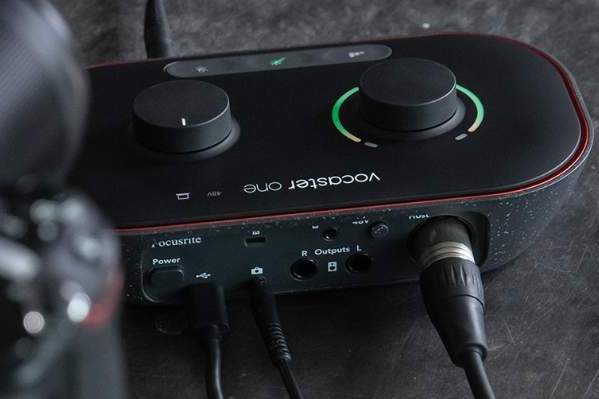
Every good quality podcast starts with excellent quality sound and structure. Distortion, echoing, choppy audio or audio bleeding into your headset are sure ways to turn viewers away. This means there’s a big emphasis on your recording equipment and how much you’re willing to invest. However, most people won’t want to dump $1,000 or more on broadcast equipment, especially for a startup podcast or stream.
There are tons of ways you can still achieve professional sound on budget-friendly recording equipment.
One solution is the Vocaster One from Focusrite. Designed by a company that has spent decades dedicating its craft to creating the perfect audio interface tools, the Vocaster is a no-brainer for beginner podcasts. Not only is it a high-quality audio recorder, but you can also save hundreds while still getting top broadcast features.
What Does the Interface Include?
Most podcast recording equipment kits for beginners are overpriced when you include headsets, mics, recorders, and software. The Vocaster One essential kit comes with a DM1 mic (DM14v for Vocaster 2), XLR cable, USB A-C cable, and HP60v headphones for less than half the price of a traditional broadcast setup. In addition, the Vocaster comes with free recording software Hindenburg Lite, plus free three-month trials to SquadCast Pro + video. It also includes another six-month trial of free audio recording software on Acast Influencer and Hindenburg Pro.
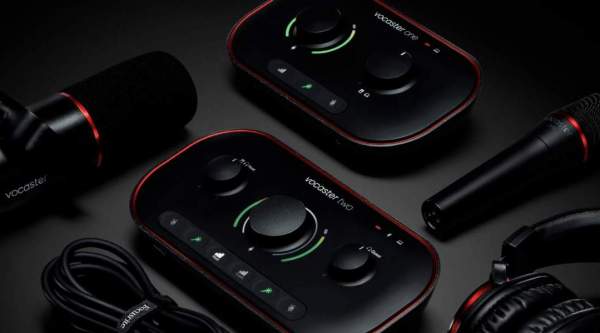
Mic & Headset
Our experts had the opportunity to use the well-polished audio equipment and loved every second of it. The mic has a built-in shock mount and windshield to diminish unwanted noises while keeping your voice load clear. The closed-back headset pairs perfectly by not allowing the sound to leak into the mic and cause echoing.
Enhanced Audio Features & Filters
Want enhanced audio features as well? The Vocaster has a few easy-to-use audio components that give you professional sound quality without tediously tweaking post-production. These sound features are perfect for anyone learning to use podcast equipment as a beginner. The Vocaster will automatically set gain levels for you and comes with an “Easy Start” tool and 24/7 customer support.
You have the option to play with four different voice filters or mute yourself with the press of a button. If you have a visual blog, you can seamlessly pair the audio and video using one TRS cable. Plus, a TRRS cable can bring in guests and friends through phone calls and record whatever music or audio you need to make your podcast sound great.
The Vocaster is compact, light, and portable, with a simple interface for any beginner to start podcasting immediately. It is small, so it won’t take up too much space for your podcast setup and is cost-effective.
Med. Level (Video Podcast) – Blue Yeti Microphone & Logitech C922 Webcam
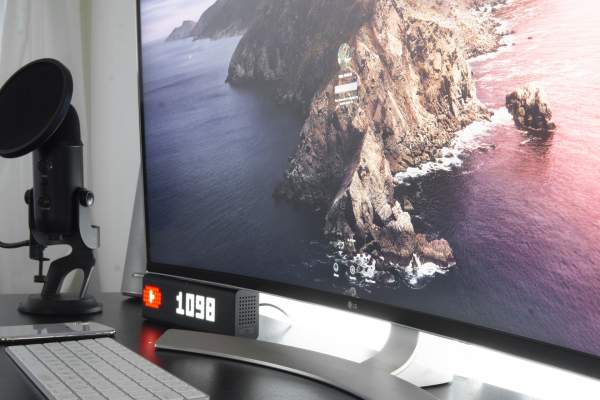
If you’ve been podcasting for a while now, or you want to transition from a solely audio podcast to a visual one. Investing in the Yeti mic and Logitech C922 Pro Webcam is an excellent option for making video podcasts. Knowing how to make a professionally styled video is essential, and the C922 webcam and software do a great job at simplifying that. Today, hosting services like YouTube are among the most preferred podcast platforms to listen to.
Video & Streaming Features
The C922 Pro shoots crisp 1080p 60fps video for podcasts or streams, while the Yeti Blue mic captures clear 16-bit 48 kHz resolution. The mic has latency-free monitoring, an instant mute feature, and gain control for pristine sound quality. The podcast equipment setup is stress-free and can be quickly assembled in minutes.
The professional mixture of audio and visual elements that the webcam and mic offer are all for less than $250. You can adjust mic levels, change pick-up patterns, and control volume in a cinch for the Yeti Blue mic. As for the C922 Logitech webcam, you can shoot video for podcasts or be able to stream directly to services like YouTube and Twitch. It is equipped with autofocus and light correction to capture vibrant colors and detail in your podcast videos. Not to mention the elimination of lag or distortion for smooth podcast streams.
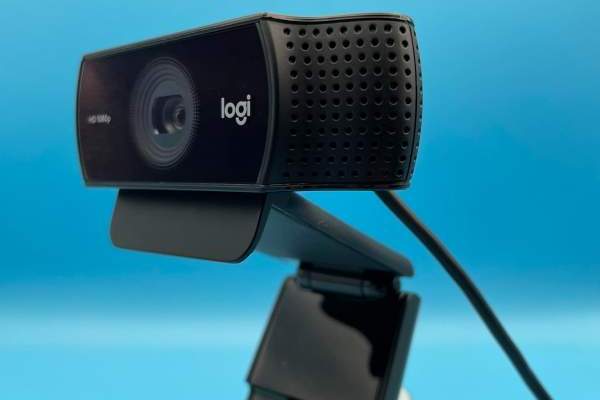
Logitech Webcam C922 Software
The Logitech software for webcams is just as capable as its paired hardware. You’ll receive three months of Xsplit premium with the bundle purchase. Logitech software for webcams also comes with Logi Tune and G Hub for various useful streaming and video controls.
The webcam comes with Logitech drivers and software to help adjust settings and support if needed. The Logitech software lets you control aspects like video panning, the field of view, colors, exposure, and even autofocus. As for live streaming, you can utilize apps such as Xsplit, OBS, or OBS Streamlab for a boosted user experience and professional properties.
The Blue Yeti mic with the Logitech webcam combo is vital for good quality streaming and video podcasting. We highly recommend these tools if a visual podcast is something you are interested in.
Advanced Podcast Setup – Rode RODECaster Pro Podcast Production Studio
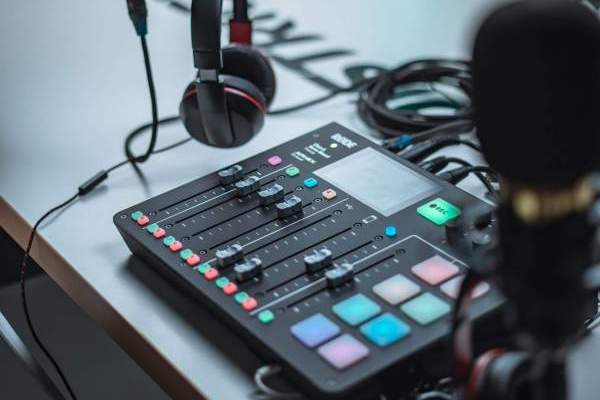
When you think of slightly more advanced equipment for a recording studio, the RODECaster Pro immediately comes to mind. This is a fully integrated audio recording system that can be suited for all types of podcasters. However, due to its dense interface, the RODECaster Pro is typically more beneficial to seasoned broadcast professionals. It allows you to accommodate a four-person podcast setup with four mics inputs, USB and Bluetooth channels, eight music pads, audio processing, and powerful preamps.
Audio Quality & Features
As mentioned, you can connect up to 4 mics in addition to 4 headphones for the RODECaster Pro interface. Every mic has a preamp, and you control each channel on the board. Furthermore, you can manage all volumes and outputs via the touchscreen pad.
The RODECaster has top-of-the-line audio quality due to its low-noise signals and refined sound. Mix this with a compressor, high-pass filter, APHEX Aural Exciter, and Big Bottom broadcast effects, and you have a professional-sounding podcast on your hands. The eight pads are handy for a well-structured broadcast that uses intros, outros, music, sound bites, and more.
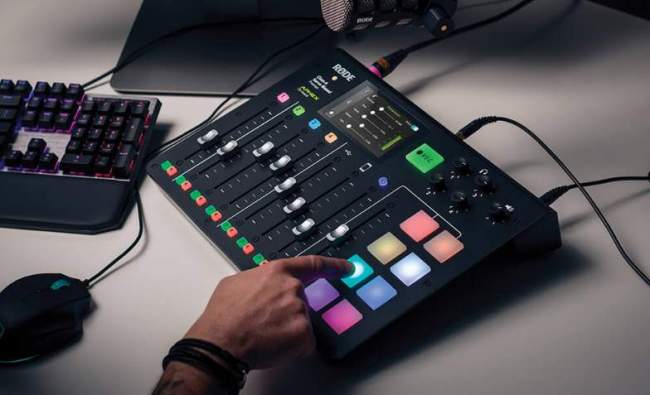
Phone Usage & Remote Capabilities
The RODECaster is optimized for phone calls, so you can perform remote interviews or work with members who are distant. Just like the Vocaster One, all you have to do is plug in your phone using a TRRS cable, or you also have the option of using Bluetooth. However, it has slightly more features using audio controls like “mix-minus” to prevent the caller from hearing echoing or the “mute-caller” button.
RODECaster Recording Options
As for audio recording software, the RODECaster Pro is considered a standalone and therefore doesn’t require a computer to operate. You record directly to a microSD card. However, you can use a USB to connect to your laptop, converting it to an impressive audio interface. You can perform multi-track recording using other audio recording software programs such as Audition, Logic, ProTools, and more.
Although the RODECaster is more suitable for those with well-rounded broadcast knowledge, constant firmware updates have made the process of post-production much more manageable. It has been enhanced to let you control DAW faders with the MIDI control for seamless computer to RODECaster communication. If you are streaming with multiple cams, you can also switch scenes or cams using the MIDI control.
Take Away
There is a podcast setup that fits everyone, from the newbies to semi-pros to experts, and the broadcasting opportunities are endless. Putting together a well-produced podcast isn’t easy but is becoming more accessible using the audio interfaces we have today.
How will you take your broadcasting to the next level, and what devices most interest you?










